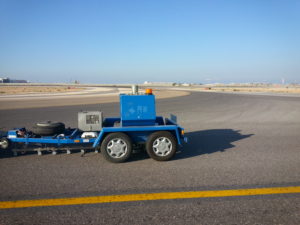Delivering effective solutions for the airport most important asset
 On existing pavements, there is the need to assess their bearing capacity in order to:
On existing pavements, there is the need to assess their bearing capacity in order to:
- test the actual bearing strength of a new pavement, just after construction. This is required by ICAO in order to define the bearing capacity that needs to be published in the AIP (Airport Information Publication);
- periodically, to update AIP information;
- after a major maintenance work, in order to assess the new bearing values;
- whenever the pavement starts to show signs of deterioration, in order to assess its current bearing capacity and its residual lifetime.
This is done by assessing the pavement PCI (Pavement Condition Index) and its PCN (Pavement Classification Number).The PCN is compared with the ACN (Aircraft Classification Number) to check whether certain types of aircraft can operate on the designated runway or taxiway.
This process involves Non Destructive Testing on the pavements carried out with the HWD (Heavy Weight Deflectometer) equipment. HWD test provides detailed information of the pavement behavior under similar to real conditions connected to aircraft loading cycles.
 The large amount of test results on various alignment of the pavement are processed in order to assess the correct PCN value to be used as reference.
The large amount of test results on various alignment of the pavement are processed in order to assess the correct PCN value to be used as reference.
When pavements show failures, cracks, deflections, most of the times is too late to carry out proper maintenance and only local temporary fixes can be done. The aim of a PMS or an APMS (Airport Pavement Management System) is to plan pavement maintenance before failures start to appear. This is done in 3 steps:
- collection and recording of information on pavement conditions;
- analysis and maintenance planning;
- monitoring the conditions.
Information on actual pavement conditions are collected through surveys:
- HWD test to identify local weaknesses and residual pavement life;
- profile survey to evaluate longitudinal roughness and surface irregularities;
- GPR scan to assess the layer’s thickness and localize infrastructure anomalies;
- video inspection through LCMS, topographic direct survey & GIS to map pavement cracks.
All the information collected through the survey are uploaded into a specific database. Each portion of the pavement is analyzed and a specific maintenance plan is defined. This allows a proactive approach that prevents failure and subsequent service disruptions.
